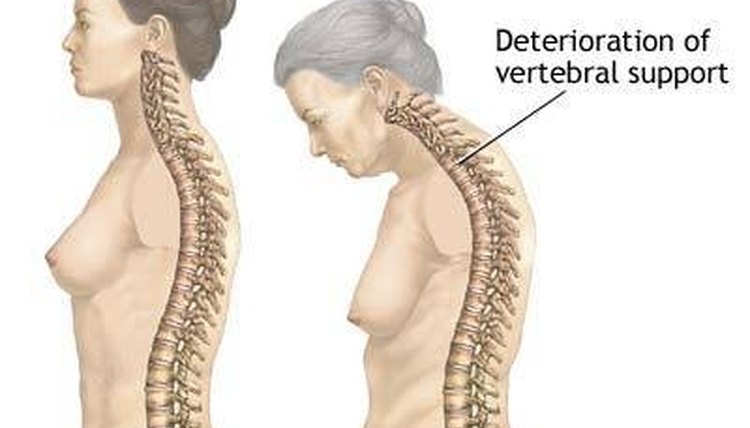Exercise for a Dowager's Hump

The best course of action is, of course, not getting a dowager's hump in the first place. Once you have it, you cannot get rid of it; but you can take preventive measures to avoid this condition.
Kyphosis
A dowager's hump (kyphosis) is an advanced form of osteoporosis that results in a bent-over position. In severe cases, the individual is so bent over that her face is facing the ground. The condition got its name because of the frequency with which older women used to develop this condition. Women, and men, still develop dowager's humps, but a lot more is known about the prevention and treatment of osteoporosis than was known in the past.
Dowager's Hump or Hunchback Avoidance
To avoid kyphosis, or a hunchback or dowager's hump, first and foremost make sure that you are getting enough calcium into your body. Don't wait until you are 50 years old to do this. Start early. Secondly, engage in specific kyphosis exercises, which should prevent you from developing a hump. In addition, keep moving. If you sit too much, your abdominal muscles will weaken and the hamstrings in the back of your legs will tighten up. This makes a person slouch and develop a hump.
Chest Stretch
Do the chest stretch, according to Pilates-back-joint-exercise.com (see References). This entails lying on a mat with your knees bent and your hands placed at the base of your skull. Gently press your elbows into the floor. You will feel a pull under the armpits and across your chest. Keep your ribs and shoulder blades against the mat at all times. Release your elbows and then repeat this exercise until you can feet the tight muscles in your chest releasing tension.
Hamstrings
While lying on the floor, use an exercise rope or band to execute the hamstring stretch. Wrap the band underneath one foot and hold onto the ends of the band with your hands. Your other leg is extended to the front and flat on the floor. Exhale and lift your leg (the one that has the band situated underneath the foot) straight up. Give a slight tug on the band. You should feel a tug in the back of the upper thigh. Hold this position for a couple of seconds and then lower your leg to the floor, letting up on the tension band. This will strengthen your legs, which support you, and enable you to maintain better posture.
Lateral Row
Sit on a mat with your back straight and both of your legs extended to the front. If your hamstrings are tight, bend your knees. Wrap an exercise band around your feet. Hold the ends of the band with both hands. As you pull your hands toward your waist, exhale. The palms of your hands should be facing each other. Continue pulling on the band. Your elbows will move to the back. Your shoulder blades will draw together. Repeat this movement 10 times. This is a good back exercise and is called the lateral row.
Spine
Dr. Sydney Bonnick, director of Osteoporosis Services at the Cooper Clinic in Dallas, recommends doing this exercise for the spine: Lying on your stomach with a pillow under your pelvis, place your arms and hands palm sides positioned upward and alongside your body. Anchor your feet under a bar at the bottom of a chair or under the sofa. Slowly raise your head and shoulders. Hold and then lower them. Repeat this several times. If you already have spine fractures, do not do this exercise without first consulting with your doctor. This is comparable to the cobra pose in yoga, except your hands are positioned palms down when doing the cobra.
Balance and Coordination
Work on your balance and coordination, which will help prevent falls that can result in breaks. Walk on your toes; walk on your heels. Do the grapevine: Step your left foot across and in front of your right foot and then step your right foot to the right. Repeat, moving to the right. Step down on your left foot to the left and step across and in front of your left foot with your right and repeat, moving to the left.
Behind the Back
Clasp your hands behind your back and pull your hands away from your back. Your shoulder blades will move toward one another. You will feel this in your arms and in your lower back.
Avoid These Activities
Exercises that you want to avoid, according to Osteopenia3.com, include toe touching or any movement that requires you to bend forward at the waist. Spontaneous crush fractures can occur when coming out of this position. Avoid jogging, jumping rope, high-impact aerobics, running, soccer, football and hockey. However, you can engage in progressive weight lifting, walking and stair climbing.
Writer Bio
Cindi Pearce is a graduate of Ohio University, where she received her bachelor’s degree in journalism. She completed both the undergraduate and graduate courses offered by the Institute of Children’s Literature. Pearce has been writing professionally for over 30 years.
